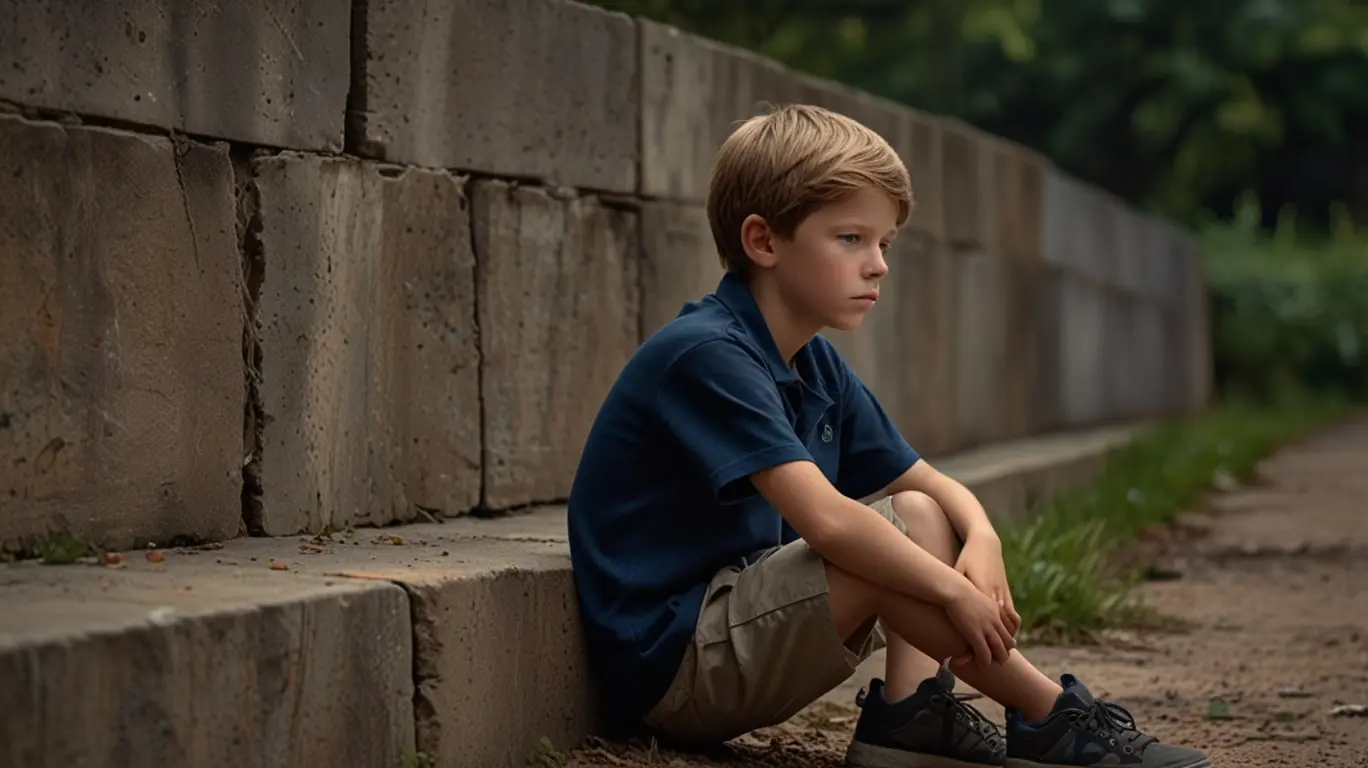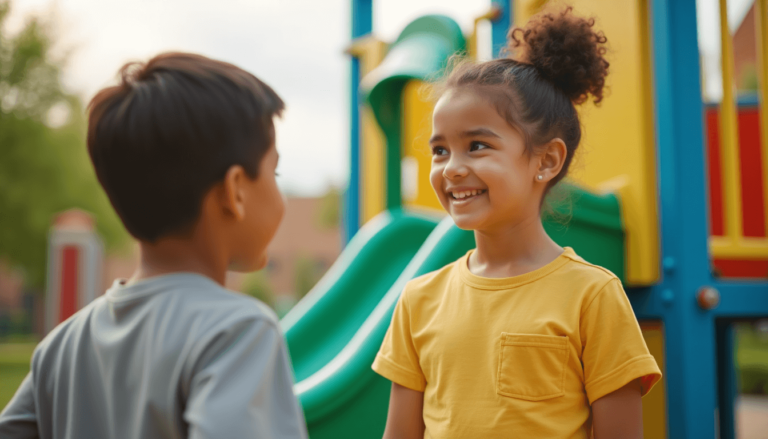Childhood is meant to be a time of joy, exploration, and learning, but for many children, anxiety can cast a shadow over these experiences, making everyday situations feel overwhelming. As a parent, it’s tough to watch your child struggle with worries that seem beyond their control, and it can be challenging to know how to calm an anxious kid. The good news is that with the right strategies, you can guide them through these anxious moments and empower them to feel more in control. One such tool is the 3-3-3 technique, a simple yet effective exercise that helps calm an anxious kid by grounding them in the present through focusing on three things they can see, hear, and touch.
One of the simplest and most effective tools to help children manage anxiety is something you may not have heard of: the 3-3-3 technique. This easy-to-remember method can make a world of difference in helping your child calm their racing mind, and the best part? It can be done anytime, anywhere. In this article, we’ll guide you through how the 3-3-3 technique works and how it can become your go-to strategy when anxiety takes hold. Get ready to discover a tool that could bring immediate relief and long-term benefits for your child.
In the sections that follow, we will delve deeper into recognizing the signs of anxiety in children, explore common causes, and share additional strategies to complement the 3-3-3 technique. Our goal at Lulabico is to provide parents with the resources and guidance needed to support their children through anxiety, helping them grow into confident, resilient individuals.
Recognizing the Signs of Anxiety in Your Child: What Every Parent Should Know
As a parent, you’re naturally tuned into your child’s physical needs and well-being. But when it comes to their mental health, especially anxiety, the signs can be much more subtle and harder to detect. Recognizing these early warning signs is crucial in helping you calm an anxious kid and manage their anxiety before it becomes overwhelming.
Key Behavioural Signs to Watch For:
To help kids develop self-compassion, focus on three things. By practicing these principles, children can learn to treat themselves with kindness, feel connected to others, and navigate challenges with resilience and confidence.
In Younger Children:
- Clinginess: If your child suddenly becomes more attached to you, even in familiar situations like daycare or playdates, this could be a red flag for anxiety. They may refuse to separate from you in environments they previously enjoyed, showing hesitation where they once felt confident. This shift in behavior suggests that they’re seeking comfort and safety amid growing inner fears.
- Frequent tantrums: While tantrums are typical for young children, a sudden increase in their intensity or frequency—especially around specific situations—could indicate anxiety. For instance, your child may throw a tantrum every time it’s time to leave the house or face bedtime. These emotional outbursts could reflect their difficulty managing overwhelming feelings they don’t yet have words for.
- New fears: Children experiencing anxiety often develop new, seemingly irrational fears that weren’t present before. For example, they may suddenly be terrified of the dark, strangers, or even routine objects like the vacuum cleaner. These fears often act as a projection of their internal anxiety, even if they seem unrelated to the real source of worry. Helping to calm an anxious kid during these moments requires patience and understanding, as well as guiding them through these fears with reassurance.
In Older Children:
- Social withdrawal: An anxious child may begin withdrawing from social activities or friendships they once cherished. If your child, for instance, suddenly stops going to soccer practice or avoids hanging out with friends, this can signal a deeper struggle with anxiety. Their avoidance is likely an attempt to reduce the discomfort they feel in social or unfamiliar settings.
- Constant worrying: Older children often express their anxiety through endless “what if” questions, especially about everyday concerns like school or friendships. You may notice them obsessing over worst-case scenarios, unable to focus on the positive or the likely outcomes. This cycle of worry can consume their thoughts, making even minor situations feel overwhelming.
- Physical complaints: Anxiety frequently manifests in physical symptoms like recurring headaches, stomachaches, or unexplained fatigue. Your child may complain of these symptoms without an obvious medical cause, which is often their body’s way of signaling emotional distress. These complaints can intensify around stressful situations, such as before school or a social event.
Understanding the Difference Between Normal Worry and Anxiety
It’s natural for children to feel nervous or worried at times, especially when facing new or challenging situations. So how do you know if your child’s behavior is just a phase or something more serious? The key is to observe the frequency and impact of their worries.
| Normal worries | Anxiety |
| are short-lived and don’t typically interfere with your child’s daily life. For instance, it’s normal for a child to feel nervous about their first day of school or before a big test, but these fears should pass once the event is over. | on the other hand, persists and affects your child’s ability to function. For example, if your child consistently avoids school or withdraws from activities they once enjoyed, or if their worries stop them from sleeping, eating, or interacting with others, it’s likely more than just everyday worry |
Questions to ask yourself:
- Is your child’s anxiety causing them to avoid things they used to enjoy?
- Do they spend more time worrying than playing or engaging with others?
- Is their anxiety disrupting family routines, friendships, or schoolwork?
If the answer is yes, it might be time to take a deeper look and seek professional support. Early intervention is key, and addressing anxiety before it escalates can significantly help to calm an anxious kid, improving their emotional well-being and giving them the tools to manage their fears effectively.
Opening Up the Conversation
Talking to your child about anxiety can feel challenging, especially if they’re young or unsure how to express their feelings. Start by letting them know it’s okay to feel anxious and that you’re there to help. Use simple language, such as describing anxiety to younger kids as a “worry cloud” they can manage with tools like deep breathing. For older kids, explain that anxiety is a normal stress response that can be controlled.
Encourage open conversation by creating a safe space. Ask gentle, open-ended questions like, “I’ve noticed you’ve been worried. Can you tell me what’s on your mind?” Validate their feelings by saying, “I understand this feels hard for you right now,” instead of dismissing their concerns. This approach helps them feel heard and supported.
Practical Guide to Help Your Child Manage Anxiety
Once you’ve identified that your child is struggling with anxiety, it’s natural to want to find effective ways to help them cope. While every child is different, and what works for one might not work for another, there are practical strategies you can try to calm an anxious kid. By incorporating these techniques into your daily routine, you can help your child feel more secure and better equipped to manage their feelings.
Step 1: Establish Consistency and Routine
Children with anxiety often benefit from a structured routine. Establish regular times for meals, homework, play, and bedtime. A predictable schedule provides a sense of security, reducing anxiety triggered by uncertainty.
If your child finds mornings stressful, try creating a morning routine that includes a quiet breakfast and a brief mindfulness exercise, such as deep breathing together. This can help them start the day feeling calm and prepared.
Step 2: Encourage Mindfulness and Relaxation
Mindfulness techniques help children stay present and reduce anxious thoughts. Simple practices, such as focusing on their breath or paying attention to their surroundings, can be incorporated into daily life.
At bedtime, ask your child to sit quietly and focus on their breathing for a few minutes. You might also guide them through a “body scan” exercise where they relax each part of their body from head to toe. This helps them unwind and prepare for sleep.
Step 3: Encourage Physical Activity
Physical activity is a natural way to reduce anxiety, as it releases endorphins that elevate mood and decrease stress.
Encourage your child to participate in activities they enjoy, like riding their bike, playing a sport, or even dancing around the living room. Going for a walk together after school can also provide an opportunity to chat about their day and release pent-up energy.
Step 4: Foster Open Communication
Create an environment where your child feels safe to talk about their feelings without fear of judgment. Regularly check in with them to see how they’re doing and offer reassurance.
If your child seems upset after school, you might say, “I noticed you seem a little anxious. Do you want to talk about what’s bothering you?” Encouraging this dialogue makes it easier for your child to open up, and it provides an opportunity to offer guidance.
Step 5: Celebrate Progress and Build Resilience
Celebrate small victories, such as using a coping skill during an anxious moment, to reinforce positive behavior. Encouraging your child to view challenges as opportunities for growth can also help them develop resilience.
If your child successfully uses the 3-3-3 technique before a stressful event, praise them for their effort. You might say, “I’m so proud of how you handled your nerves today by using your breathing technique. Let’s do something fun to celebrate!”
Step 6: Take Care of Yourself
Supporting a child with anxiety can be emotionally taxing, so it’s essential to care for your own mental health. Make time for activities that help you relax and recharge.
Carve out a few minutes each day for yourself, whether it’s a quiet cup of coffee, a short walk, or reading a book. Remember, taking care of your well-being enables you to be a stronger support system for your child.
But did you know there’s a way to enhance this method even further?
Introducing the Bonus 3-3-3 Technique—a refined version that not only grounds your child in the present but also helps build long-term resilience.
The Power of the 3-3-3 Technique
One of the most effective tools you can use to calm an anxious kid is the 3-3-3 technique. This simple grounding exercise helps when your child is feeling overwhelmed by anxiety. By focusing on three things they can see, touch, and hear, the technique draws their attention away from anxious feelings and helps them reconnect with their surroundings, providing a sense of control and calm.
Here’s how you can guide your child through the 3-3-3 technique in a gentle, supportive way:
Step 1: Identify 3 Things You Can See Ask your child to look around and name three objects they can see. It could be their favorite toy, the family pet, or a picture on the wall. This shifts their focus from anxious thoughts to their environment. You can say, “Can you spot three things in the room?”
Step 2: Identify 3 Things You Can Touch Encourage your child to notice three things they can physically feel—like the softness of a blanket, the coolness of a table, or their clothing. Ask them to describe the texture or temperature. For example, “What does your blanket feel like?”
Step 3: Identify 3 Things You Can Hear Have your child close their eyes and listen for three sounds, such as the ticking of a clock or distant voices. Focusing on these sounds helps ground them. You can ask, “What sounds can you hear around you?”
The beauty of the 3-3-3 technique lies in its simplicity—it can be done anytime, anywhere, making it an accessible tool for children of all ages. Whether your child is feeling anxious at home, at school, or out in public, this technique can help them regain a sense of control and calm.
How to Apply It with Kids?
- Make it a Game: Turn the 3-3-3 technique into a playful activity so your child is more likely to engage. You can frame it as a “scavenger hunt” for sights, sounds, and textures.
- Practice Together: Especially for younger children, they may need your guidance in the beginning. You can practice the technique together by taking turns identifying objects, making it a shared experience that strengthens your connection.
- Use it Regularly: Encourage your child to use the technique anytime they feel overwhelmed, whether they’re anxious about going to school or feeling nervous about a new situation. Regular practice can help make it a go-to tool for managing anxiety.
As you continue on the journey of helping your child manage anxiety, remember that support is available every step of the way. At Lulabico, we provide a wealth of resources tailored for parents, including expert articles, practical tools, and access to a community of supportive families facing similar challenges. Whether you’re looking for guidance on anxiety management strategies or emotional support.
Additional Resources
In addition to Lulabico’s offerings, there are many books, apps, and professional services that can provide further assistance in managing your child’s anxiety. Some excellent books that provide practical advice include:
- “The Whole-Brain Child” by Daniel J. Siegel and Tina Payne Bryson: This book explains how to nurture your child’s developing brain while providing strategies to address emotional challenges, including anxiety.
- “Freeing Your Child from Anxiety” by Tamar Chansky: A hands-on guide filled with practical strategies to help parents reduce their child’s anxiety.
- “What to Do When You Worry Too Much” by Dawn Huebner: This is an excellent workbook for kids, designed to give them tools to understand and manage their anxiety.
For those who prefer digital support, several apps can be useful tools in managing anxiety, such as:
- Mindshift CBT: Based on cognitive behavioral therapy principles, this app helps children and teens reframe anxious thoughts and develop coping strategies
- Smiling Mind: A mindfulness app that provides age-appropriate meditation exercises designed for children and teens.




